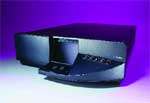
QuBit custom-configured its ST digital cinema server for use in China. Twelve of them were sold there in 2002.
|
At $125,000 to $250,000 per digital cinema screen, theatre owners can't justify replacing ($25,000) film projectors that still run. With plenty of film content and patrons on the ticket lines, there's no compelling reason to jump into digital cinema - especially when the industry hasn't even settled on a standard.
For now, the consensus - by the DCI (Digital Cinema Initiative, which is made up of representatives from the major film studios) - is that digital cinema requires a DLP Cinema projector, which is currently offered by only licensed vendors Christie, Barco and Digital Projection, Inc., the latter of which recently entered into a marketing agreement with NEC. All three of these companies offer projectors based on the Texas Instruments DLP Cinema chip.
So, without a DLP Cinema projector, a theater won't be considered a legitimate digital cinema venue by Hollywood movie studios, and therefore, won't be allowed to show major motion pictures.
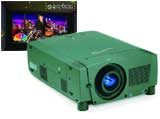
Regal says by replacing its static slide shows with video -- such as outtakes from Leno -- projected on Christie Roadrunners, they are gearing up for the d-cinema future.
|
An example of DLP Cinema quality is Christie's DCP-H projector, which uses a three-DMD chip from Texas Instruments (TI), producing 3.9 million pixel (1280 x 1024) images with 4.4 trillion colors and a contrast ratio of 1350:1 onto a 50-foot-wide screen.
TESTING THE WATERS
Regal CineMedia (RCM), a major US cinema chain, has decided to deploy non-DLP Cinema digital projectors - initially for 1,400 screens in 1st quarter 2003, and 4,500 screens in all by the end of 2003. But they won't be showing feature films.
In a contract with Christie Digital (www. christiedigital.com) in Cypress, CA, Regal is acquiring the projector-maker's non-DLP RoadRunner L6, controlled by ChristieNet networking modules. Instead of movies, Regal's new national Digital Content Network will deliver alternative video content, including entertainment, sports, educational programming and advertising.
"This is a strategic move that will allow us to begin laying the groundwork for the future of this business - digital cinema," says NYC-based Lauren Leff, VP of communications for Regal CineMedia. "Our infrastructure will easily upgrade to DLP Cinema when it becomes affordable. This is a stepping stone toward that goal and a learning process for our employees."
Before Regal's film-projected feature presentations, they will replace their static slide show with a 20-minute video pre-show, "which will be 65 percent original shortform content and 35 percent advertising," says Leff. "We've struck programming deals with four major networks. One of the networks is NBC, which will supply three- to four-minute segments, featuring the cast of Friends, outtakes from The Tonight Show With Jay Leno and primetime news programs." In its initial testing, Regal featured a seven-minute documentary by Capital Records on the making of George Harrison's final recording "Brainwashed," which Leff says was well received by audiences.
"Our goal is to enhance the movie-going experience through the use of digital technology, and Christie has consistently demonstrated their willingness to explore new applications and develop the technology necessary to assist Regal in the seamless integration of a complex network," says Tom Galley, chief technical officer, Regal CineMedia.
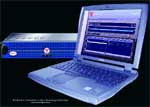
Avica currently has 22 FilmStores in China; they expect to be in 100 theatres there in 2003.
|
D-CINEMA TAKES OFF... in CHINA
While digital cinema is off to a slow start in the US, sales are increasing in China. "The People's Republic of China is moving aggressively to implement digital cinema to improve their standard of living, inform and entertain their people and create a feeling of community, all of which cinema does well," says Harry Mathias, Barco's (www.barco.com) LA-based director of digital cinema, US.
"Since the Chinese lack a TV set in every home, the best way to connect everyone is through cinema. To do this, they are skipping over film entirely and going straight to digital cinema. So far, we placed 16 Barco D-Cine Premiere [THX-certified] digital cinema projectors in theaters in China in the initial wave of installations. When their plans are realized, there will likely be more digital cinema projectors in China than in the US if we don't get moving quickly," adds Mathias.
Barco is hoping that one way to spur demand in the US, and elsewhere, is by introducing a new, lower-cost projector - the new Barco DP-30, priced 25 percent lower and targeting smaller-scale installations. This full-featured digital cinema projector is designed for a maximum 33-foot-wide screen.
"The theory behind the DP-30 is that there are many post houses that want to put a digital cinema projector in their mastering and color timing suites, but knocking down a wall to accommodate a projection booth is not an option," says Mathias. "The DP-30 lets them work within those space constraints without quality compromises."
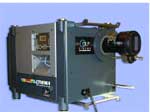
DPI and NEC's Digital Projection Cinema is introducing two new models in 2003. One is the compact is10 (pictured), suitable for post houses and smaller cinemas.
|
Also, he adds, "post houses don't need to worry about their projectors becoming obsolete. We at Barco swapped our older digital cinema models with the new D-Cine Premiere at our own cost so our customers wouldn't be penalized for being early adopters."
TEAM PLAYERS
In October 2002, Manchester, England's Digital Projection International (DPI) formed a joint venture with NEC Viewtechnology Ltd., a subsidiary of NEC in Japan, to develop and market digital cinema projectors worldwide under the brand name of Digital Projection Cinema - except for the Japanese market where the NEC brand will prevail.
"This joint venture combines NEC's manufacturing capabilities and credibility as a leading projector vendor with DPI's research and development experience and well-developed marketing channels and expertise," says Peter Nicholas, head of marketing and sales, Digital Projection Cinema, North and South America, for DPI.
While Nicholas is based in Ventura, CA, Digital Projection's (www. digitalprojection.com) US subsidiary is based in Kennesaw, GA. As a result of DPI's union with NEC, two new projectors will be marketed starting the first quarter of 2003. The first is a compact projector (with an integrated lamp rather than in an external lamp house). Called the Digital Projection Cinema is10, this innovative projector is priced 30 percent lower than most DLP Cinema projectors, while delivering full three-chip DLP Cinema (at 1280 x 1084) quality, with 7,000 ANSI lumens, in a user-friendly projector.
"The is10 was designed for projection onto a 36-foot-wide maximum screen size, making it ideal for post production and smaller cinemas," says Nicholas. "Then, in March 2003, we will come out with a larger-scale DLP Cinema projector, with 12,000 ANSI lumens and 1280 x 1024 resolution, which will be upgradable to Texas Instrument's next-generation chip (now in development) and up to 20,000 ANSI lumens. The post community should have confidence in our joint effort's commitment to maximizing their investment in the inevitable digital cinema future."
SERVING THE PROJECTORS
Avica, which offers a comprehensive open standards-compliant product line - from mastering to encoding and encryption to presentation management (but not projectors) - provided its end-to-end "platform" to Lucasfilm in San Rafael, CA, for mastering and digital playback for the digital release of Star Wars: Episode II - Attack of the Clones.
Lucasfilm used Avica's StillStore, a multi-standard, scalable solution for capturing and storing high-quality, uncompressed still images, to analyze, at a pixel-by-pixel level, the output of the Sony CineAlta 24p HD camera for image quality control on location. Also, Avica's MotionStore, an uncompressed digital media processing platform optimized for capture of motion or still images as HD digital data, was used at Skywalker Sound to provide playback of uncompressed HD images during audio mixing. And finally, Lucasfilm's Industrial Light & Magic used Avica's DataStore, which provides scalable storage for Avica's mastering products, to encode, secure and package the digital movie data in formats for worldwide distribution via satellite and DVD.
"We encoded, encrypted and packaged 11 different dubbed and subtitled versions in just four days to enable the digital release to open in 11 different countries on the same day with the required image quality and content security" says Andy Maltz, president/CEO of Avica Technology Corporation (www.avicatech.com) in Santa Monica.
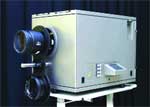
Barco's smaller-sized DP-30 is targeted to post houses for mastering and color timing applications.
|
One of the digital cinema chains that showed Star Wars: Episode II is run by China Film Group Corporation, which deployed Avica FilmStore, a digital cinema theater management system, which includes the A500 single screen server and the A2900 central server, in 10 of its venues. An Avica FilmStore also provided playout for a preview screening of Star Wars: Episode II - Attack of the Clones during the Shanghai Film Festival in June. Also, China Film Group's Hua Long Digital Productions and Stellar Megamedia of Beijing acquired Avica mastering systems to produce distribution masters of digital content produced in China.
"While 22 Avica FilmStores have been deployed in China, their plan is expand to 100 theaters in 2003," says Maltz. "We've been successful with both large digital cinema distributors, like Boeing Digital Cinema, which installed our server at all of their US installations, as well as with independent operators such as the Star City digital cinema in Prague. Star City showed the recent Harry Potter and the Chamber of Secrets from a digital distribution package produced by a new division of our company, Avica Services Group, which [serves] digital cinemas not associated with a digital distributor that want to acquire digital content."
QuVis is another server company working in the d-cinema space. "In fall of 2002, we sold a dozen QuBit systems through our distributors in China as part of that nation's move toward digital cinema," says Jim Graham, product manager for QuVis (www.quvis.com) in Topeka, KS. "We custom-configured our QuBit ST digital cinema server to meet their needs, and our engineers are overseeing the installations." (QuVis also has several server installations at digital cinemas in large shopping/entertainment complexes located above train and subway stations in Tokyo, Japan.)
"Older theaters typically don't have adequate wiring and climate control to support digital cinema equipment, particularly servers, and these modifications must be taken into account when converting to digital cinema," says Graham. "Whereas, when we installed our QuBit servers at the new AMC-24 in Chicago, the optimal infrastructure there enabled them to go right into place."
This year, QuVis is delivering its core technology on an ASIC chip for better performance and higher resolutions at a lower unit cost. Instead of MPEG, QuBit servers use a DCT-based algorithm, which enables them to scale upwards easily and cleanly. "When you increase the color depth or resolution to 2K or 4K, it's a linear progression, so the data rate and processing become unwieldy. With MPEG servers, you'll lose some fidelity and see aliasing in the image, whereas with DCT, our servers produce the visually pristine experience movie studios are seeking."